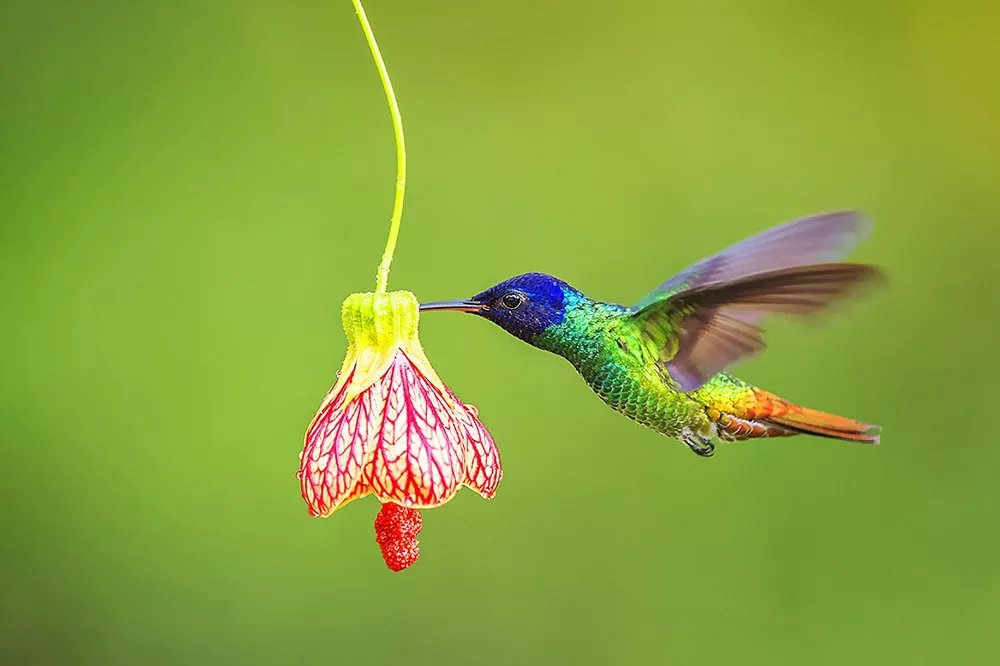Hummingbirds are unique and fascinating birds, known for their small size, agility, and colorful plumage. They are also known for their high metabolism and voracious appetite, as they require a lot of energy to sustain their rapid wing movements. Hummingbirds primarily feed on nectar, which is a sugary liquid produced by flowers, and insects, which provide them with protein and other nutrients. In this article, we will explore the diet of hummingbirds in more detail, including what they like to eat and how to attract Hummingbirds to your garden.
Nectar
Nectar is the primary source of food for hummingbirds, and it provides them with the energy they need to sustain their flight. Nectar is a sugary liquid that is produced by flowers to attract pollinators, including hummingbirds. Nectar is high in carbohydrates, which are essential for providing the energy that hummingbirds need to fuel their flight. Hummingbirds have a long tongue that is specially adapted to drink nectar from deep within flowers. They use their tongues to lap up nectar at a rate of up to 15 times per second.
Hummingbirds prefer nectar that is high in sugar content, and they are particularly attracted to flowers that produce red, orange, and pink blooms. Some of the flowers that hummingbirds like to feed on include:
- Bee Balm
- Cardinal Flower
- Salvia
- Trumpet Vine
- Honeysuckle
- Fuchsia
- Red Hot Poker
- Penstemon
Insects: An Essential Protein Source
In addition to nectar, hummingbirds also need to consume insects to get the protein and other nutrients that they require. Hummingbirds are known for their aerial acrobatics, and they use their agility to catch insects in mid-air. Hummingbirds typically eat small insects, such as mosquitoes, fruit flies, and gnats. They also eat spiders and other arthropods.
Hummingbirds are attracted to areas with high insect activity, as this increases their chances of finding food. If you want to attract hummingbirds to your garden, consider planting flowers that attract insects, such as marigolds and zinnias. You can also provide a source of water, such as a bird bath or fountain, as this will attract insects and provide a drinking source for hummingbirds.
Tree Sap: A Sticky Treat
Another surprising addition to the hummingbird’s menu is tree sap. When insects feed on sap, it forms a sugary residue that attracts hummingbirds. These birds skillfully extract the sap using their delicate tongues. While tree sap is not a primary food source, it offers additional nutrients and energy supplements to hummingbirds, especially during periods when nectar availability is low.
Fruits and Soft-Bodied Invertebrates: Occasional Delights
Hummingbirds are known to occasionally indulge in soft fruits, such as ripe bananas, berries, and melons. These fruits provide an alternative source of sugars and are often sought after when natural nectar sources are scarce. Additionally, some species of hummingbirds consume small soft-bodied invertebrates like spiders, caterpillars, and aphids. While these items are not a staple part of their diet, they offer variety and essential nutrients for optimal health.
Pollen and Tree Resins: Unconventional Choices
Hummingbirds inadvertently consume pollen while feeding on nectar-rich flowers. Although pollen does not serve as a significant food source, it provides trace amounts of protein and other nutrients. Additionally, certain hummingbird species have been observed pecking at tree resins. While the exact reasons behind this behavior are not fully understood, it’s believed that resins may help with digestion or provide medicinal benefits.
Sugar Water Solutions: Supplementing Nectar Availability
To attract hummingbirds to your garden, you can create homemade sugar water solutions as a supplement to natural nectar sources. Use a mixture of one part white granulated sugar dissolved in four parts distilled water. Avoid using honey, as it may contain harmful bacteria. Place feeders filled with the sugar water solution near windows or hang them in shaded areas. Remember to clean and refill the feeders regularly to prevent bacterial growth.
See Also: How to make sugar water for Hummingbirds (A Full Guide)
Conclusion
Understanding what hummingbirds like to eat is essential for creating environments that appeal to their dietary needs. By providing a diverse array of food sources, including nectar-filled flowers, insects, tree sap, fruits, and sugar water solutions, you can attract hummingbirds to your garden while promoting their health and well-being. So, grab your binoculars and create a haven that entices these enchanting avian wonders to visit and delight you with their vibrant presence.


 Facebook
Facebook  Instagram
Instagram  Youtube
Youtube 